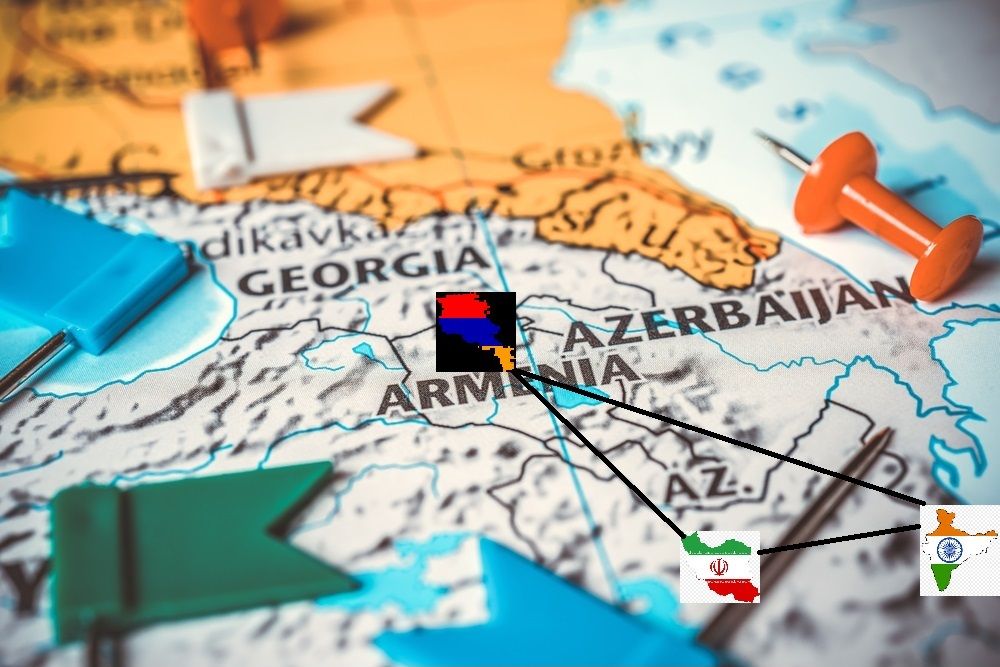Iran’s attempt to form new power triangle, disrupt stability in South Caucasus

Since the history of independence, two currents have existed in the South Caucasus: constructive and destructive tendencies. Historically, Azerbaijan's location at the most strategic point of the region has led to many advantages for it. However, the 30-year occupation period prevented the country from implementing a number of advanced projects.
Finally, after November 2020, Azerbaijan chose a decisive turning point in the path of economic development. The country began to attract the interest of European and world countries with its unprecedented advantages in the field of energy tourism and many other spheres. Emerging perspectives have created the need for the long and huge transport route connecting the West and the East (Middle Corridor) to be put into operation soon.
Azerbaijan as the most vital segment of this huge transport route
Azerbaijan's incredible victory in the Patriotic War also revealed its friends and enemies around it. For some reason, Iran, which turned a blind eye to the 30-year occupation, openly sided with Armenia in Azerbaijan's rightful war. This biased approach also led Iran and Armenia to unite in many insignificant projects with an obscure future. In April 2023, the issue discussed at the meeting of the Deputy Ministers of Foreign Affairs of Iran, Armenia and India in Yerevan was supposedly the prospects of new economic cooperation, or the creation of a new tripartite format in the South Caucasus and the drawing up of new maps.
The formation of this tripartite format has a number of key strategic implications that could disrupt the geopolitical balance in the South Caucasus.
In fact, the main reason that brought Iran and Armenia closer was known: Tehran’s effort to restore the balance of power in the South Caucasus after the Second Karabakh War.
Because Iran, thanks to its dirty intentions, understood very well that there were no conditions left for its existence in the region. In addition, Azerbaijan's fraternal alliance with Turkiye and Pakistan threatened the political "future" of both Tehran and its sister city, Yerevan. In particular, as a symbol of the brotherhood of Azerbaijan, Turkiye and Pakistan, the military drills started in 2021 turned into a nightmare for both countries. Thus, the attempt of Iran and Armenia started a new insidious game under the name of cooperation with the involvement of India as well.
Zangazur Corridor or the most sensitive vein of Iran
Whether it is the BRI or the International North South Transport Corridor (INSTC), Azerbaijan's active and leading role in both projects did not make Iran happy. First, the issue of the Zangazur Corridor becomes an important factor in the development of the BRI project. And this collides with a point that Iran does not like the most - the fear of severing the relations between Iran and Armenia through the only border in Azerbaijan’s Zangazur. Although the Azerbaijani official presented Tehran with alternative means for this, it did not work. Iran, on the other hand, brought Armenia to the forefront to overshadow the importance of Azerbaijan and even sat at the same table with official Yerevan in the negotiation of the Persian Gulf-Black Sea International Transport and Transit Corridor project.
Indian Ocean dreams of Armenia and Iran
Since Iran is an oppressed state in the region and the world, it always has to choose allies similar to itself. Unable to cooperate with normal countries, Tehran chooses countries that match its character and disposition in the economic field. It is no coincidence that Iran chose Armenia as its most suitable ally in the Persian Gulf-Black Sea International Transport and Transit Corridor project. Both the realities that happened in the region (the end of 30-year occupation of Azerbaijan’s territories), the Russian-Ukrainian war, and the imposed sanctions caused Iran to start cooperation with Armenia and India on new projects. Iran sees both countries as its only way out of the West’s economic pressure.
For instance, the Port of Chabahar, in the Sistan and Baluchistan province of southeastern Iran, represents the transit and commercial bridge between Iran, India and Armenia. This facility has turned vital as it is the only Iranian port with direct access to the Indian Ocean. Parallel to the participation of Russia and China in the Chabahar Port project, including investments in both the Shahid Beheshti and Shahid Kalantari parts of the Chabahar Free Trade–Industrial Zone (FTZ), which have grown since the war in Ukraine began, Armenia has also shown more attention to this Iranian port project in further developing transit and trade with India.
At the same time, all these plans were not as simple as they seemed. Along with creating a new economic alliance, Iran began to develop a policy of disruption in the region, similar to its sister state, Armenia. In order to isolate Armenia from the region and block the Zangazur Corridor, which is important for the world, Iran purposefully opened a diplomatic office in the province that Armenia calls it Sunik. Undoubtedly, this was a policy prepared by Tehran deliberately against the realization of the Zangazur Corridor.
However, Iran also overlooked the main nuances. The first is whether it is the free trade zone of Aras that it announced, or the INSTC project, no matter how much Tehran tries to prioritize Armenia in all these large-scale projects, the reality says its final word.
In a nutshell, despite all the evil intentions of Iran towards Azerbaijan, the Iran-Azerbaijan-Russia land route, which is a part of the INSTC project, has once again left Armenia behind in its quality and importance.
Yerevan’s inadequate transit infrastructure and the still incomplete “North-South highway” are the main problems in this regard. The 400-kilometer road from Yerevan to Meghri on the Iranian border passes through mountainous areas and is very narrow, making it difficult and slow to pass through for trucks, especially during the winter. Furthermore, the lack of a rail connection between Iran and Armenia has reduced the volume and speed of goods transferred along this portion of the corridor. Therefore, for the foreseeable future, the passage running through Iran, Azerbaijan and Russia (Astara-Baku-Dagestan) will remain the INSTC’s primary route. At the moment, on average, a truck crosses the shared border of Iran and Azerbaijan every seven minutes.
However, sticking to its pro-Armenian and envious nature, Iran will likely try to transfer at least part of this traffic to the Armenian-Georgian land route and the Iranian-Russian sea route in the Caspian. As the saying goes, Leopard will never change his spots. Iran's intention is not for stability and development in the region and the world, but rather to develop all conflicts both from the outside and by direct participation.
---
Elnur Enveroglu is AzerNews’ deputy editor-in-chief, follow him on @ElnurMammadli1
Follow us on Twitter @AzerNewsAz
Here we are to serve you with news right now. It does not cost much, but worth your attention.
Choose to support open, independent, quality journalism and subscribe on a monthly basis.
By subscribing to our online newspaper, you can have full digital access to all news, analysis, and much more.
You can also follow AzerNEWS on Twitter @AzerNewsAz or Facebook @AzerNewsNewspaper
Thank you!

